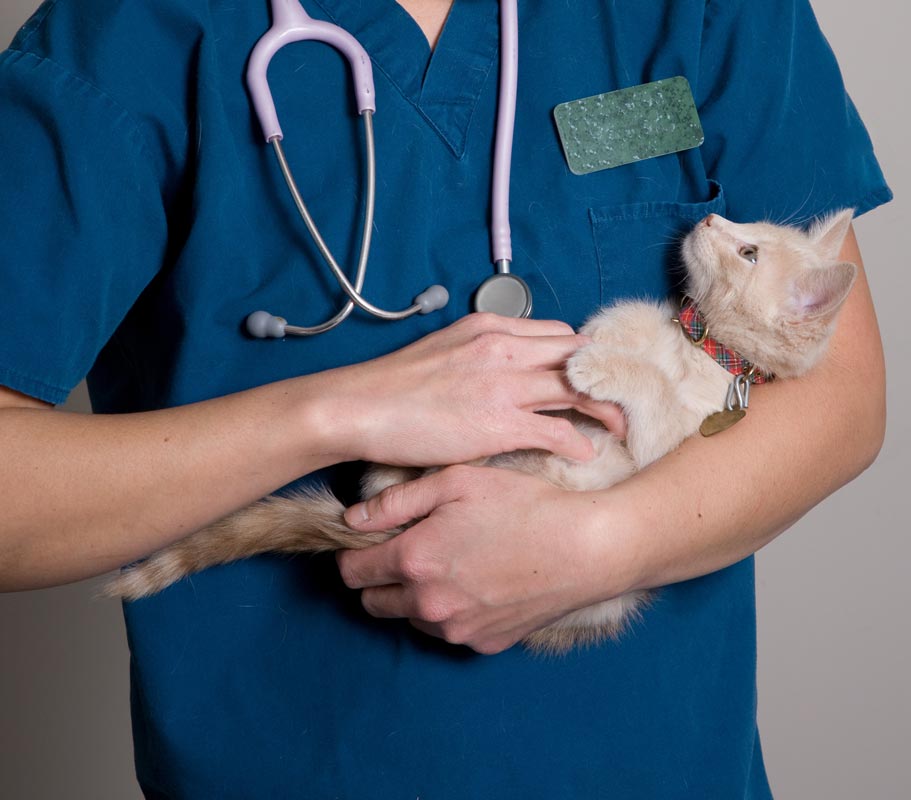Common Diagnostic Tests in Cats

Cats are not very good at sharing their problems. In fact, they are well known to hide illness until it is in advanced stages. Here, you can learn about common diagnostic tests that your veterinarian may perform to localize a problem.
Diagnostis in Cats: Tests, Tests and More Tests!
This is just what you might be thinking as the veterinarian informs you that several tests need to be run to help find out more about your kitty! It might seem like a lot, but it is money well spent.
Cats can't tell us how they're feeling; in fact, they tend to hide illness well. This means that we often rely on diagnostic testing to help us localize or characterize a cat's problem. We also do wellness screening to determine whether everything is working OK in there. A lot of conditions cannot be picked up based on a physical examination or by taking a thorough history. Early blood cancer, early kidney disease, early heart disease and other conditions may be identified on tests well before clinical signs of the illness occur.
Tests may also be done to monitor disease progression or success of drug management. Serial blood sugar tests for diabetics, or kidney function tests for chronic kidney disease are examples of this type of strategy. Cost of tests varies considerably. Some tests that need to be sent out to laboratories may take some time to be reported, so patience is needed in some instances.
So what do all of these test names mean? Here are some of the most common tests done on cats and what they tell your veterinarian.
CBC
The complete blood count is frequently recommended because it provides a great deal of information about the red cells that carry oxygen, the white cells that protect the cat from infections, platelets that help blood clotting, and the liquid portion of the blood called the plasma. Cell counts, the proportion of red cells (hematocrit, PCV [packed cell volume]) and different classes of white cells, the size and shape of cells, and microscopic appearance of the cells (maturity, granules, staining) are all carefully determined.
Blood Profile
Also termed blood screen or blood chemistry panel, this test provides important information about blood components such as sugars, proteins, and electrolytes (potassium, sodium etc). Additional tests may be done to assess hormones (thyroid hormones etc). Organ function assessments are routinely included. Particularly important are the tests that measure function of the liver and kidneys.
Viral Screen
Your veterinarian will recommend viral testing of new cats, cats going outdoors, breeding/cattery/multi-cat household cats, and cats exposed to sick cats. Feline leukemia virus(FeLV) and feline immunodeficiency virus (FIV) are the standard. Testing for feline infectious peritonitis (FIP) will not be done routinely, but in certain circumstances such as early weaning programs for catteries, testing may be suggested.
Fecal Tests
This test requires that you bring your veterinarian a fresh sample from the litter box of the kitty’s bowel movements (poop). The staff will run a flotation test to determine whether parasite eggs are present, and they may also run a smear to look for single-celled parasites such as Giardia. It sounds yucky, but is an essential part of preventive health care for cats. In kittens, even if eggs are not found in the first sample, de-worming treatments will be recommended due to the risk of transfer of some of these gut parasites to people.
Urinalysis
Getting a sample of urine at home can be tough with cats. Placing a bit of plastic wrap over the litter loosely may allow you to gather a clean urine sample. The sample needs to be very fresh and kept cool until dropped off at the hospital. Otherwise, in order to get a sample, veterinary staff will either express the bladder at the hospital or perform a cystocentesis, which is a procedure that introduces a very small needle through the body wall into the bladder to obtain a sterile urine sample. This latter method will be used if the urine is being cultured for infections. Urine will also be checked for excess sugar or protein, concentration, color, and the presence of bacteria, crystals, and excess red or white cells.
Skin Scraping and Other Parasite Tests
If your kitty is scratching or if the veterinarian suspects she carries ringworm, a hair pluck/toothbrush and fungal culture will be done. A black light may also be shone over the fur and skin. If mites are suspected, a blade is passed over the skin to remove a layer of skin cells, and this is called a skin scraping. Scabies and demodex type mites live below the skin surface, and a deep scraping will be done to find these. Don’t worry if the skin surface bleeds a bit. This means the test is being done properly. Surface mites (>Cheyletiella) may be harvested by a surface scraping, scotch tape prep, or just a visual examination with a magnifying glass for the fur mites. An otoscope will be used to check for ear mites, and sometimes a smear of debris is mounted under the microscope to look for the mites.
Electrocardiogram (ECG)
This test is done the same way in cats as it is in people. A few clips are placed on the skin at set locations. This is a quick procedure and causes no discomfort, so most cats sit happily while the ECG recordings are done. This is an important screening test in cats since heart disease may not show up as an obvious illness until it is quite advanced.
Routine Survey Radiography (X-Rays)
Chest x-rays are frequently suggested for senior cats, cats with chronic respiratory disease such as asthma, or cats that are suspected to have heart disease.
Dental x-rays may be used to monitor the health of the roots of the teeth in cats. Cats affected by inflammation of the mouth tissues (periodontitis, stomatitis, marked gingivitis), cat “cavities” (termed FORLs or feline odontoclastic resorptive lesions), or broken or misaligned teeth will all benefit from this test.
Hip and stifle x-rays may be taken to monitor cats in certain breeds known to be at high risk for hip dysplasia or displaced knee caps (luxating patella). The Devon rex, Maine Coon, and Abyssinian breeds are examples of breeds with suspected increased risk.
Your veterinarian will be happy to explain costs, risks and benefits, and what the purpose of a test is if you are not sure.
You May Also Like These Articles:
FIV: Feline Immunodeficiency Virus
FIP: Feline Infectious Peritonitis in Cats
Notice: Ask-a-Vet is an affiliated service for those who wish to speak with a veterinary professional about their pet's specific condition. Initially, a bot will ask questions to determine the general nature of your concern. Then, you will be transferred to a human. There is a charge for the service if you choose to connect to a veterinarian. Ask-a-Vet is not manned by the staff or owners of CatHealth.com, and the advice given should not delay or replace a visit to your veterinarian.






